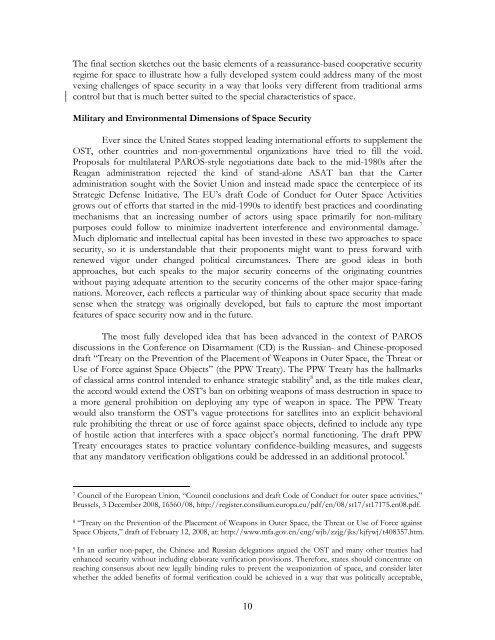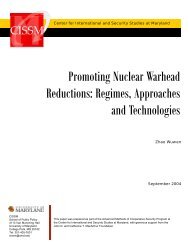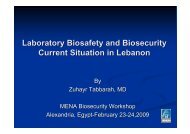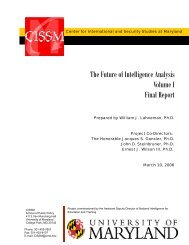A Reassurance-Based Approach to Space Security - Center for ...
A Reassurance-Based Approach to Space Security - Center for ...
A Reassurance-Based Approach to Space Security - Center for ...
- No tags were found...
Create successful ePaper yourself
Turn your PDF publications into a flip-book with our unique Google optimized e-Paper software.
The final section sketches out the basic elements of a reassurance-based cooperative securityregime <strong>for</strong> space <strong>to</strong> illustrate how a fully developed system could address many of the mostvexing challenges of space security in a way that looks very different from traditional armscontrol but that is much better suited <strong>to</strong> the special characteristics of space.Military and Environmental Dimensions of <strong>Space</strong> <strong>Security</strong>Ever since the United States s<strong>to</strong>pped leading international ef<strong>for</strong>ts <strong>to</strong> supplement theOST, other countries and non-governmental organizations have tried <strong>to</strong> fill the void.Proposals <strong>for</strong> multilateral PAROS-style negotiations date back <strong>to</strong> the mid-1980s after theReagan administration rejected the kind of stand-alone ASAT ban that the Carteradministration sought with the Soviet Union and instead made space the centerpiece of itsStrategic Defense Initiative. The EU’s draft Code of Conduct <strong>for</strong> Outer <strong>Space</strong> Activitiesgrows out of ef<strong>for</strong>ts that started in the mid-1990s <strong>to</strong> identify best practices and coordinatingmechanisms that an increasing number of ac<strong>to</strong>rs using space primarily <strong>for</strong> non-militarypurposes could follow <strong>to</strong> minimize inadvertent interference and environmental damage. 7Much diplomatic and intellectual capital has been invested in these two approaches <strong>to</strong> spacesecurity, so it is understandable that their proponents might want <strong>to</strong> press <strong>for</strong>ward withrenewed vigor under changed political circumstances. There are good ideas in bothapproaches, but each speaks <strong>to</strong> the major security concerns of the originating countrieswithout paying adequate attention <strong>to</strong> the security concerns of the other major space-faringnations. Moreover, each reflects a particular way of thinking about space security that madesense when the strategy was originally developed, but fails <strong>to</strong> capture the most importantfeatures of space security now and in the future.The most fully developed idea that has been advanced in the context of PAROSdiscussions in the Conference on Disarmament (CD) is the Russian- and Chinese-proposeddraft “Treaty on the Prevention of the Placement of Weapons in Outer <strong>Space</strong>, the Threat orUse of Force against <strong>Space</strong> Objects” (the PPW Treaty). The PPW Treaty has the hallmarksof classical arms control intended <strong>to</strong> enhance strategic stability 8 and, as the title makes clear,the accord would extend the OST’s ban on orbiting weapons of mass destruction in space <strong>to</strong>a more general prohibition on deploying any type of weapon in space. The PPW Treatywould also trans<strong>for</strong>m the OST’s vague protections <strong>for</strong> satellites in<strong>to</strong> an explicit behavioralrule prohibiting the threat or use of <strong>for</strong>ce against space objects, defined <strong>to</strong> include any typeof hostile action that interferes with a space object’s normal functioning. The draft PPWTreaty encourages states <strong>to</strong> practice voluntary confidence-building measures, and suggeststhat any manda<strong>to</strong>ry verification obligations could be addressed in an additional pro<strong>to</strong>col. 97 Council of the European Union, “Council conclusions and draft Code of Conduct <strong>for</strong> outer space activities,”Brussels, 3 December 2008, 16560/08, http://register.consilium.europa.eu/pdf/en/08/st17/st17175.en08.pdf.8 “Treaty on the Prevention of the Placement of Weapons in Outer <strong>Space</strong>, the Threat or Use of Force against<strong>Space</strong> Objects,” draft of February 12, 2008, at: http://www.mfa.gov.cn/eng/wjb/zzjg/jks/kjfywj/t408357.htm.9 In an earlier non-paper, the Chinese and Russian delegations argued the OST and many other treaties hadenhanced security without including elaborate verification provisions. There<strong>for</strong>e, states should concentrate onreaching consensus about new legally binding rules <strong>to</strong> prevent the weaponization of space, and consider laterwhether the added benefits of <strong>for</strong>mal verification could be achieved in a way that was politically acceptable,10







